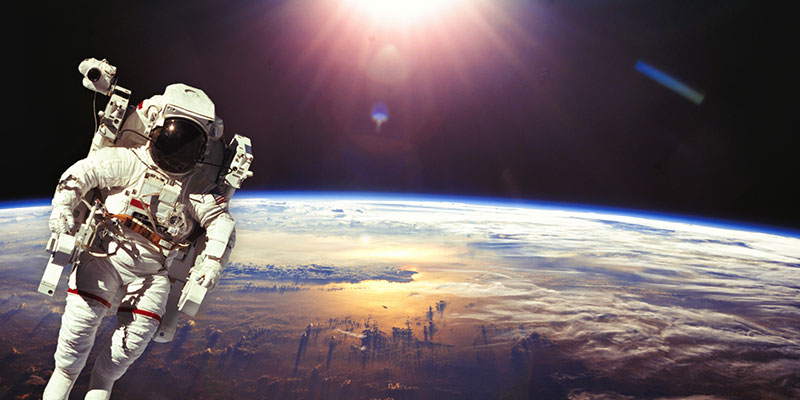Space travel has captivated children for generations, from kids watching the moon landing in 1969 to young girls learning about Sally Ride in 1983.
This generation is no different. However, instead of hearing stories about people in space from reporters here on Earth, this generation has a chance to communicate with astronauts directly as they conduct spacewalks and orbit around our home planet.
Secure your helmets, buckle your seatbelts and prepare your kids for Story Time From Space.
What Is Story Time From Space?
Story Time From Space is a series of videos created by astronauts at the International Space Station. With the backdrop of the Earth behind them, the astronauts read from a collection of children’s books, teaching kids about space in a fun and creative way. Teachers and parents love watching their kids’ eyes light up seeing a real-live astronaut sharing some of their favorite books.
Story Time From Space is an initiative by the Global Space Education Foundation, an educational nonprofit that advocates for all sectors of the space industry. Since 1983, it has worked to connect, educate and inspire people to get involved and support the global space community.
Which Books Have Been Sent Into Space?
As you can guess, most of the books read in Story Time in Space have a distinct theme: science and the great beyond!
One author, who has been featured multiple times, is Dr. Jeffrey Bennett. Bennett sent six of his books to the space station and has been an advocate of the program from the start. He created a series of books featuring Max, a dog, and his friends, who travel through space and learn about the universe. So far, Max has gone to the moon, Mars, Jupiter, and the Space Station, where his story was read by astronaut Mike Hopkins.
Parents and educators who want to follow the Story Time in Space series can regularly check the website to see what’s coming up. At the top of the list to be read on the International Space Station is “Next Time You See a Sunset” by Emily Morgan. This is part of her “Next Time You See” series, which has books about fireflies, pillbugs, seashells, and the moon. The books invite readers to learn about something they might see every day and not think about.
“Next Time” will be followed by “A Moon of My Own,” by Jennifer Rustgi, a book about a young girl who travels the world and learns about nature with her faithful companion — the moon.
The books featured on Story Time in Space don’t have to be connected directly to space, but they will speak to children’s curiosity to learn about the world around them.
How Has Story Time in Space Been Received?
So far, kids can’t get enough of stories read by their favorite astronauts.
In an article for Edutopia, Ben Johnson says that responses to the program have been overwhelmingly positive, with the organizers receiving hundreds of emails worldwide. This inspired them to take storytime one step further. Now, astronauts are performing science experiments along with the readings to further combine the worlds of space, reading, and imagination.
The popularity of the program has also started a conversation about the importance of storytime in the classroom and home.
“The ‘magic’ lies in the way stories potentially engage children’s hearts and minds, as people and as thinkers, with issues that are relevant, real, and important to them,” author Carol Reid says. Space is cool, but the content of the stories keeps kids engaged until the end.
Other education professionals agree. “When we read, we share experiences, hopes, joys, and sorrows all while engrossed in a good book,” the team at Barbershop Books writes. “When mom, dad, auntie, uncle express their shock at the big plot twist in the book, kids notice this and are even more excited.”
Astronauts are able to form emotional connections with kids back on Earth by sharing a reading journey with them — connections to science and space that aren’t easily broken.
Are There Other Storytime Broadcasts to Follow?
Fans of Story Time in Space might find themselves looking for other broadcasts to help their kids discover a new favorite book or to learn valuable lessons. Here are just a few of our favorite presenters and programs you can check out to bring books to life.
- Bedtime FM is an independent podcast producer that features Story Time, a podcast that features bedtime readings by guest authors. The podcast is never longer than 20 minutes to keep younger students engaged.
- Developed by the SAG-AFTRA Foundation, Storyline Online features actors reading children’s books accompanied by illustrations. Viola Davis, James Earl Jones, and Betty White are just a few actors who have participated to promote literacy for the next generation.
- Author Brad Meltzer has a series of StoryTime videos on his website that feature readings and re-enactments from his “I Am” series. Barbara Bush even stopped by to read “I Am Lucille Ball” to support her literacy foundation.
- Younger learners might enjoy Story Time With Ms. Becky, a YouTube series designed for kids 3 to 10. At the end, Ms. Becky’s assistant, Bear, poses questions that help readers think critically about what they just learned and the lessons behind the books.
- Sydney Soli developed Storytime Yoga for Kids, where parents and kids stretch and act out multicultural tales through yoga poses.
Storytime has the power to introduce kids to new worlds and ideas. It can instill a curiosity about the world, and even outer space, by introducing characters and sharing adventures. Check out Story Time From Space and the other resources above to spark your child’s imagination and get them excited to learn.









